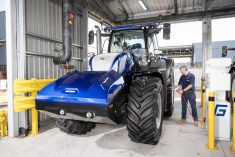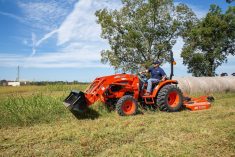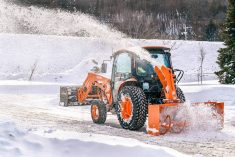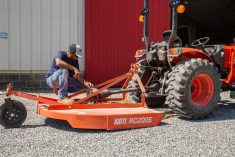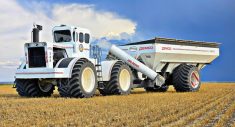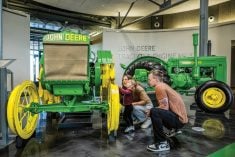A new training tool to help teach, demonstrate and predict tractor rollovers has been developed by Keystone Agricultural Producers (KAP), Red River Community College and the University of Manitoba School of Agriculture. The Mini Roll Over Training Tractor (ROTT) has been developed to educate people about the causes and dangers of rolling a tractor.
According to Safe Work Manitoba, rollovers, falls and contact with tractor attachments are the No. 1 causes of tractor-related injuries and deaths. Being that most farms operate tractors, regardless of farm size, the team decided this was a necessary place to start teaching to a future audience of farm workers and agriculture students alike.
Read Also

Gentle treatments for pain in the neck
Heading toward year-end, people unknowingly tense up against the cold and busyness, causing neck pain that can often be treated with appropriate support and gentle mobility, athletic therapist Kathlyn Hossack says.
According to Safe Work Manitoba, rollovers, falls and contact with tractor attachments are the No. 1 causes of tractor-related injuries and deaths. The new tool will help educate people about the causes and dangers of rolling a tractor.
“Knowing that farmers are the true experts when it comes to using machinery, we wanted something that was interactive where farmers could explore and discover different ways of what was safe and what wasn’t safe with a machine while they were several distances away from it and wouldn’t be injured by it,” says Thea Greene, program manager for KAP. “Our goal with this machine is to be able, in a safe way, to demonstrate how tractor rollovers do occur and, more importantly, demonstrate strategies that will help prevent rollovers.”

The electric tractor is built to the scale of a regular tractor, this way the ROTT will react the same way as a full-size tractor on the same slope. The ROTT has the capability of changing the rear tire spacing so that different operating conditions can be tested in a wide or narrow platform, allowing the team to demonstrate how wider wheel spacing can be beneficial while working on steeper terrain.
Much like a drone, the driver controls the machine with a handheld remote controller. A tablet is mounted to the controller and acts as a monitor for the tractor’s onboard camera. This allows the driver to observe the tractor’s movements from a safe distance while watching for indicators of how the tractor may roll over.
Side and rear outrigger wheels, which allow the tractor to tip over centre but not fully roll over, make it easier for the team to right the tractor back on its wheels and protects the valuable drive and navigation components inside the machine.
The ROTT has a working bucket, which can be used to simulate dangerous operating scenarios, like driving on uneven terrain with an overloaded and fully raised loader, or making sharp turns while having uneven weight in the bucket.
All of these features are just the initial steps in the first phase of this collaborative project. In the future, the team hopes to establish a designated course at the U of M’s Glenlea Research Station. The course would have differing degrees of slopes built in so that the team knows where the training tractor will and won’t roll over.
The team also hopes to add the ability to have simulated rear-mounted implements on the machine. This would serve as another variable for the team to demonstrate how rear-attached implements can affect the stability of the tractor when operating on the side of a hill.



